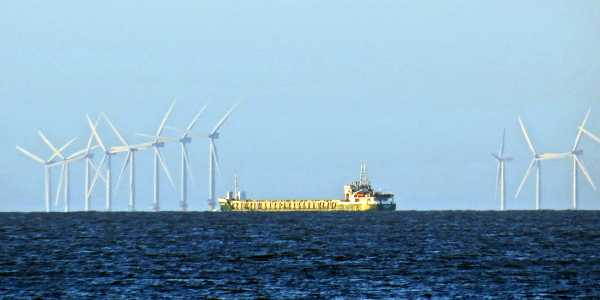
 |
Dr Callum Maciver Research Associate, Electronic and Electrical Engineering callum.maciver@strath.ac.uk |
 |
Dr David McMillan Lecturer, Electronic and Electrical Engineering d.mcmillan@strath.ac.uk |
 |
Professor Keith Bell 13 January 2017 |
This blog was originally published on the UKERC website on 4 January 2017. It is republished here with their permission.
With major offshore wind projects currently proposed or under development around the UK coast, such as on the Dogger Bank, the University of Strathclyde's Keith Bell, Callum MacIver and David McMillan describe recent technological and managerial developments that are driving down costs in this vital sector.
Just a few years ago, a lot of the chat about decarbonisation was around the potential of electricity from wind and the vast resources that lie offshore. More recently, there has been much more talk about the whole energy system and decarbonisation of heat by means other than electrification. In many ways, this is quite correct: the energy the UK is using for space, water and process heating is much greater than that used for electricity but it is far from obvious what the best options are to decarbonise all that heat demand by 2050 and current progress is slow.
For now, the low hanging fruit, it seems, still lies in the decarbonisation of electricity which means wind power, especially offshore wind power, hasn’t gone away. Two years on from the first round, the UK government has recently announced a £730m commitment for a new round of auctions for feed-in tariff contracts for difference (CfD) targeted at 'less established technologies' along with a commitment to two further rounds of funding conditional on cost reduction targets being met. Despite technological advances, the challenge of cost reduction applies just as much to offshore wind as anything else.
Challenges and opportunities for offshore wind cost reduction
When offshore wind farms were first developed commercially, the technology should really have been thought of as still being nascent. There are considerable challenges in protecting equipment from the harsh saline environment, reducing the cost of construction and foundations and in keeping operation and maintenance costs within manageable limits. Technological advances such as the advent of direct drive turbines which improve reliability by removing the need for gearboxes and the availability of higher voltage inter-array cables which reduce the total electrical infrastructure requirement have recently been made.
Couple this with the freedom to build large (up to 220m tall), high capacity (6-8MW) turbines unhindered by noise restrictions and objections on the grounds of visual intrusion and there are ample opportunities for cost savings and exploitation of economies of scale in offshore wind. Capitalising on and extending these advances is a key priority of the Offshore Renewable Energy Catapult.
Recent evidence from Europe of reducing costs
The last UK CfD round awarded contracts to some offshore wind farms for sums – between £114/MWh and £120/MWh in 2012 prices – that represented significant reductions in cost compared with what was previously built in UK waters. The latest target demands further reductions to £85/MWh by 2026. Recent experience from across Europe suggests such cost savings can and are being made with Dong Energy’s 700MW Borssele 1 and 2 farms in Dutch waters attracting a strike price, albeit excluding transmission connection costs, of €72.70/MWh in August 2016 followed in December by a winning bid of €54.50/MWh for the nearby Borssele 3 and 4 farms.
This suggests that advances in technology and diminishing perceptions of risk in these near-shore projects are already driving costs down and the phenomenon is not restricted to the Dutch market with Vattenfall’s 600MW Krieger’s Flak bid being accepted by the Danish government for €49.90/MWh this November, again excluding connection costs.
The case for co-ordinated offshore HVDC grids
For future far offshore wind farms (upwards of 100km from shore), network connection costs represent a significant proportion of the total, typically estimated at 15-25%. At these distances, HVDC connections look attractive but the industry is learning the hard way on how to make them work. The economic case is improved by maximising the utilisation of the network assets, an example of which would be designing the system so that the cables could serve the dual purposes of both bringing wind power to shore and acting as interconnection between two or more onshore regions when wind speeds are low. By developing far offshore wind connections as part of an HVDC network, the number of expensive HVDC converters can also be minimised.
PROMOTioN
The 5-year (2016-2020) PROMOTioN (Progress on Meshed HVDC Offshore Transmission Networks) project is currently the largest energy related project in the EU Horizon 2020 portfolio and involves research and development teams from across Europe, from both academia and industry. It aims to develop and demonstrate technologies that are regarded by partners as key to HVDC grid development. These include the use of much simpler HVDC converter stations at the offshore end and the short circuit fault detection and isolation equipment necessary to allow meshed operation which, in turn, allows continued operation with very few interruptions to supply.
However, the project also addresses the financial and regulatory barriers to offshore grid development and the difficulties of achieving a coordinated design that will nevertheless be realised by step-by-step developments as different wind farms get built. The barriers include alignment of different environmental and commercial regimes in different countries and questions of where the institutional responsibility for design and operation lies.
The University of Strathclyde has been involved in the early stages of PROMOTioN and has contributed chapters towards two deliverables within the 1st Work Package that are now available on the project website:
- Deliverable 1.1 which sets out a list of qualitative requirements for offshore grids and a set of fundamental topology options
- Deliverable 1.3 that provides a comprehensive assessment of the state of the art in offshore grid development.
North Sea island concept
There is tremendous potential to exploit the shallow waters of the North Sea, most notably the Dogger Bank region but this lies more than 125km from the nearest shore and innovation will be needed to meet cost control targets and secure the long term future of the industry. A radical idea has recently emerged from the Dutch transmission system operator, TenneT, to dramatically reduce the network costs by turning far offshore wind farm developments into near-shore projects by building an artificial island out at sea.
It allows for a hub and spoke connection concept with wind farms using established AC technology to connect to one or more substations on the island with high capacity HVDC links then connecting to the mainlands of Britain, Norway, Germany or the Netherlands. The island concept would provide an air strip for access and hotel accommodation for construction and maintenance staff.
The authors recommend this introductory guide to technical, commercial and regulatory issues around offshore grids.
Tags: News & Blogs